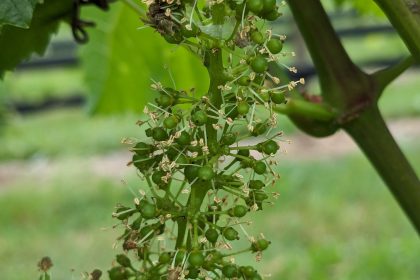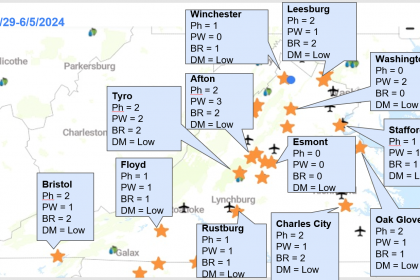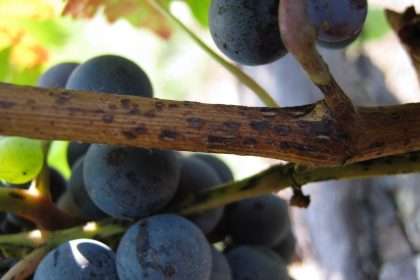Most of us are about to finish critical time when clusters are susceptible to infection by downy mildew, powdery mildew, and black rot. This critical time varies by varieties, but in general, 4 to 6 weeks and 3-4 weeks from bloom for V. vinifera and V. labrusca species, respectively. After this critical period, you should be able to relax a bit because these pathogens no longer able to cause disease on berries.
So, what’s next? As usual, disease dynamics really depends on environmental conditions, cultivars grown, and cultural practice you employ, but in general, this is the moment when you will be thinking about late season diseases such as Botrytis, ripe rot, bitter rot, and sour rot.
The spray timings for Botrytis is at bloom, bunch closure, and veraison. The pathogen seems to be active throughout the season. The main reason we recommend application of a Botrytis specific material at bunch closure is that this most likely to be the last opportunity for you to deliver the material into the clusters, especially if you grow tight cluster cultivars, such as Chardonnay.
Also, please keep in your mind that Botrytis is very well known for its capacity to overcome fungicides. Thus, a rotation of mode of action groups is very important aspect for Botrytis management. Mode of action for a particular fungicide can be found as a FRAC code, which you should be able to locate on the label. Here’s a short list of materials for Botrytis and their FRAC code in parenthesis: Elevate (17), Scala (9), Vangard (9), Switch (9+12), Inspire Super (9+3), Luna Experience (7+3), Aprovia (7), Meteor/Rovral (2), Endura* (7), Pristine* (7+11).
The material with an asterisk has a high concern on resistance development. Please note that the group 7 is considered a high risk, but I did not put an asterisk on Luna and Aprovia. I am not indicating that they are not high risk materials; I just simply do not have enough data. However, since they belong to the same mode of action group, I would be very careful on the usage.
When you are in doubt, please rotate the FRAC code because two different fungicides with two different chemical names may have the same FRAC code as you see on the list above. Also, tank-mixing with other material, such as captan, which has weak to fair activity against Botrytis, will help lowering the risk of fungicide resistance development. If you think one of fungicides you are using is not providing sufficient control, please contact Dr. Baudoin or me.
Another management tip for Botrytis is about wounding on berries. Although Botrytis is capable of causing disease by penetrating grape’s fruit skin tissues, it prefers going after wounds. Also, at bloom infection by Botrytis tends to develop into disease when grape fruit skin is damaged, but when the skin is intact, the risk of disease development will be much lower. Thus, management of the source of wounds such as insects (esp. grape berry moth), or birds, or powdery mildew at early in the season, can results in the management of Botrytis. Moreover, sour rot pathogens also really like going after wounds; so, the same wound management would be the key for the sour rot management as well.
Both ripe rot and bitter rot are considered as a warm season diseases, and in fact, people in the south tend to suffer more from these diseases; however, we can find ripe rot in Northern VA year after year. In addition, I have heard from growers from PA and MD that they are having issues with ripe rot as well.
Unfortunately, ripe rot in particular, has been misdiagnosed more than other rots. It shows up as if the berries are sunburned, thus you will see a round dark brown lesions on the top portion of an infected berry. The difference would be the tiny dots you will see within the lesion, which are fruiting bodies of the pathogen. As the time progresses, the lesion expand into the whole berry, and infected fruits become shriveled raisin-like fruits (please see the picture above). With a severe infection, you may see the majority of berries on a cluster shriveled down. Unlike sunburn, it does change the taste of the fruit and wine. Unfortunately, the change is in the negative direction, and a study showed that a consumer panel could detect only 3% contamination in the mast.
Both ripe rot and bitter rot seem to be able to infect berries from time of flowering to the harvest. Thus, protection is important, especially if you have experienced issues with these diseases in the past. Mancozeb, ziram captan, and QoI (Strobirulin) fungicides are currently recommended. Please rotate among these mode of actions because some of isolates causing ripe rot are not sensitive to some of those materials. Our recent research effort showed that fixed copper materials have a good efficacy as well, thus, it maybe a good idea to tank mix these materials with a fixed copper. (Note: due to the 66-day PHI of mancozeb, you may not have enough days remained to spray mancozeb at this time of the season.)







